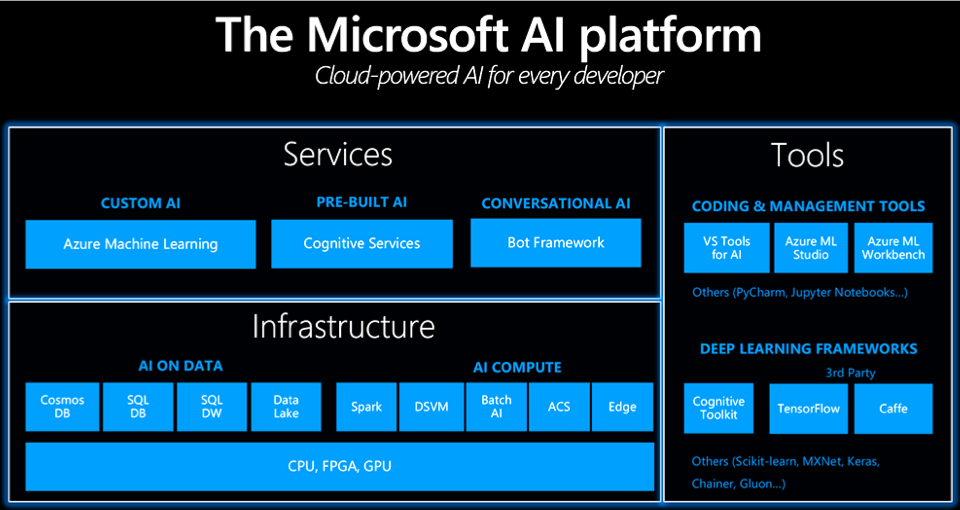
In a recent Credera blog post, John Franks discussed the basic concepts necessary to understand machine learning (ML). Once an organization understands these principles and decides that ML is worth investing in, the next logical progression is creating a vision for ML and a corresponding implementation plan. One of the first steps in that process is selecting the tools and technologies that will allow data scientists to quickly create value for the organization.
There are many tools—both free and commercial—currently available in the marketplace. The big vendors such as Microsoft, Google, Amazon, and Oracle have either adopted and commercialized free open source tools or offered their own research and internal suite of products for free to the larger community.
In this blog post, we will focus on Microsoft’s suite of ML tools and discuss how they can be leveraged to build a solid foundation for your organization’s strategic initiatives.
Overview
Microsoft continues to invest deeply in the world of artificial intelligence (AI) and machine learning (ML). From the beginning, their focus has been on both the tech-minded data science community as well as the business-oriented analyst community. Microsoft’s suite of tools allows students, developers, data scientists, data analysts, business analysts, and report developers to take advantage of the rapidly maturing landscape of AI and ML. These advances have been noticed by the tech community and Microsoft has received positive feedback in general.
“Microsoft has upped its artificial intelligence game by announcing the formation of a specialist unit that will put its AI to work on projects in healthcare, environment and education.” —Wired
Microsoft’s ML and AI offerings have grown over time in both features and maturity. The current state of the offering is pictured below.

Source: Microsoft
Broadly, the three pillars are:
1. Infrastructure on which to build the capability.
This layer offers tools for data ingestion and preparation (SSIS tools, HD Insight with Spark, etc.).
Databases and data lakes (SQL Server, Cosmos DB, HD Insight)
2. Tools for developers and business users (more details in the next section).
3. Services that are built using the tools and infrastructure that finally provide the AI and ML capabilities to end users and systems.
Artificial Intelligence (AI) solutions: pre-built solutions that can be leveraged as-is.
Integrated applications: Microsoft apps like SQL Server, Excel, etc., that have intelligence and tools built in to take advantage of the AI platform.
AI Developer Tools
Microsoft also launched a new set of tools for developers who want to build, test, and deploy solutions by using its Visual Studio Code IDE for building models with CNTK, TensorFlow, Theano, Keras, and Caffe2. Existing Office products like Excel also have embed features in them to be able to call up the AI functions from within the spreadsheets. This works in conjunction with the ML services hosted in Azure or elsewhere within an organization.
Many of Microsoft’s tools are free to try out and learn. Included in these tools is support for multiple languages, open-source packages, and the ability to visualize code and results of the processing. The tools are a way for Microsoft to engage the community of students, professionals, researchers, and commercial partners to come together to learn and contribute solution blueprints and templates for use by a larger audience and, at the same time, showcase its ML platform.
Microsoft’s AI tools include:
Azure Notebooks (including support for Jupyter, PyCharm, etc.)
Machine Learning Studio
The most important resource of all these is the Machine Learning Studio, which can be accessed by creating a free Microsoft account online here. The other tools are typically next steps in the learning process and the studio will lead students through example-based learning. There is also a rich gallery of ML experiments where other students, professionals, and organizations have contributed their work for review. This is an invaluable resource to find solutions to both general and specific business problems that any organization is looking to solve.
Start with exploring experiments in the gallery, import whatever piques your interest into your workspace, and run the experiments. There are easy tutorials to learn your way around the studio.
You can then graduate to using more developer friendly tools such as Visual Studio Code Tools for AI or Azure Notebooks (including support for Jupyter, PyCharm, etc.).
Next Steps
Microsoft is making ML more accessible than ever with their suite of tools. To leverage the content discussed in this blog post, follow the steps below and start your journey with Microsoft ML.
Create a Microsoft account.
Log in to Machine Learning Studio.
Import experiments from the Cortana Intelligence Gallery.
Explore and run the experiments and learn.
Identify a challenge in your organization and solve for it using ML Studio resources.
If your company is wondering how to better leverage ML, feel free reach out to us at marketing@credera.com. We’d love to help as you think through how your company can gain a completive advantage through machine learning.
Contact Us
Ready to achieve your vision? We're here to help.
We'd love to start a conversation. Fill out the form and we'll connect you with the right person.
Searching for a new career?
View job openings